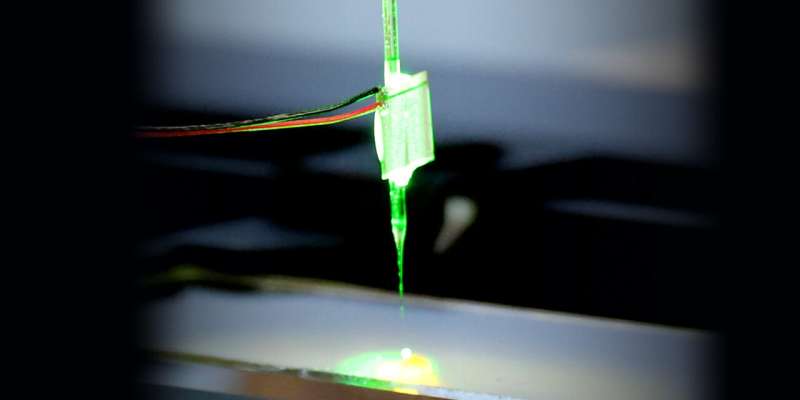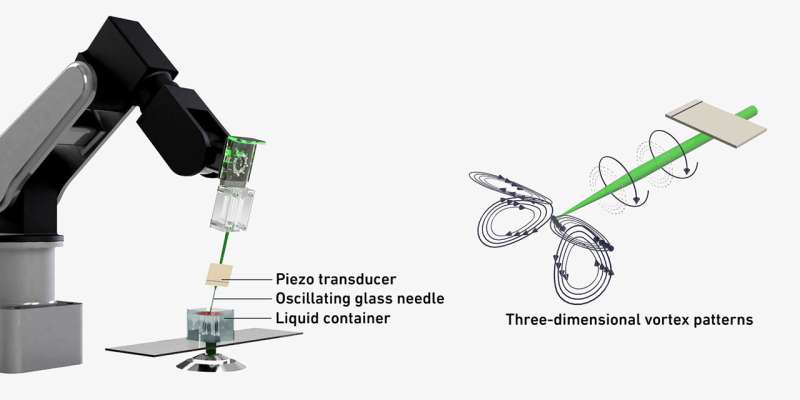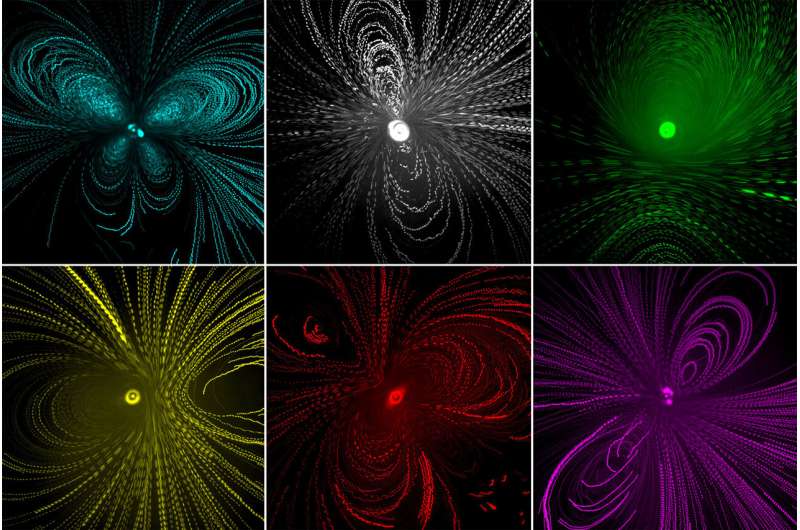This article has been reviewed according to Science X's editorial process and policies. Editors have highlighted the following attributes while ensuring the content's credibility:
fact-checked
peer-reviewed publication
trusted source
proofread
A precision arm for miniature robots

Until now, microscopic robotic systems have had to make do without arms. Now, researchers at ETH Zurich have developed an ultrasonically actuated glass needle that can be attached to a robotic arm. This lets them pump and mix minuscule amounts of liquid and trap particles.
Robots with moving arms perform mechanical work and can be programmed. A single robot can be used to carry out a variety of tasks.
Until today, miniature systems that transport miniscule amounts of liquid through fine capillaries have had little association with such robots. Developed by researchers as an aid for laboratory analysis, such systems are known as microfluidics or lab-on-a-chip and generally make use of external pumps to move the liquid through the chips. To date, such systems have been difficult to automate, and the chips have had to be custom-designed and manufactured for each specific application.
Ultrasound needle oscillations
Scientists led by ETH Professor Daniel Ahmed are now combining conventional robotics and microfluidics. They have developed a device that uses ultrasound and can be attached to a robotic arm. It is suitable for performing a wide range of tasks in microrobotic and microfluidic applications and can also be used to automate such applications. The scientists have reported on this development in Nature Communications.

The device comprises a thin, pointed glass needle and a piezoelectric transducer that causes the needle to oscillate. Similar transducers are used in loudspeakers, ultrasound imaging and professional dental cleaning equipment. The ETH researchers can vary the oscillation frequency of their glass needle. By dipping the needle into a liquid they create a three-dimensional pattern composed of multiple vortices. Since this pattern depends on the oscillation frequency, it can be controlled accordingly.
The researchers were able to use this to demonstrate several applications. First, they were able to mix tiny droplets of highly viscous liquids. "The more viscous liquids are, the more difficult it is to mix them," Professor Ahmed explains. "However, our method succeeds in doing this because it allows us to not only create a single vortex, but to also efficiently mix the liquids using a complex three-dimensional pattern composed of multiple strong vortices."
Second, the scientists were able to pump fluids through a mini-channel system by creating a specific pattern of vortices and placing the oscillating glass needle close to the channel wall.
Third, they succeeded in using their robot-assisted acoustic device to trap fine particles present in the fluid. This works because a particle's size determines its reaction to the sound waves. Relatively large particles move towards the oscillating glass needle, where they accumulate.
The researchers demonstrated how this method can capture not only inanimate particles but also fish embryos. They believe it should also be capable of capturing biological cells in the fluid. "In the past, manipulating microscopic particles in three dimensions was always challenging. Our microrobotic arm makes it easy," Ahmed says.

"Until now, advancements in large, conventional robotics and microfluidic applications have been made separately," Ahmed says. "Our work helps to bring the two approaches together."
As a result, future microfluidic systems could be designed similarly to today's robotic systems. An appropriately programmed single device would be able to handle a variety of tasks.
"Mixing and pumping liquids and trapping particles—we can do it all with one device," Ahmed says. This means tomorrow's microfluidic chips will no longer have to be custom-developed for each specific application. The researchers would next like to combine several glass needles to create even more complex vortex patterns in liquids.
In addition to laboratory analysis, Ahmed can envisage other applications for microrobotic arms, such as sorting tiny objects. The arms could conceivably also be used in biotechnology as a way of introducing DNA into individual cells. It should ultimately be possible to employ them in additive manufacturing and 3D printing.
More information: Jan Durrer et al, A robot-assisted acoustofluidic end effector, Nature Communications (2022). DOI: 10.1038/s41467-022-34167-y


















